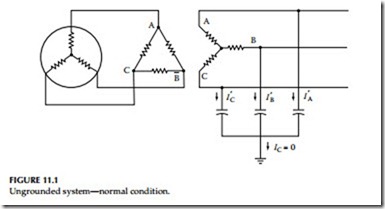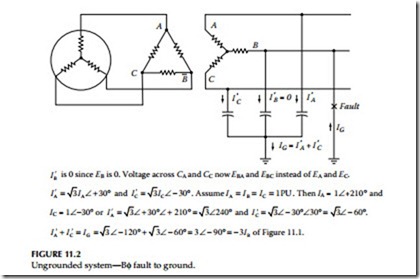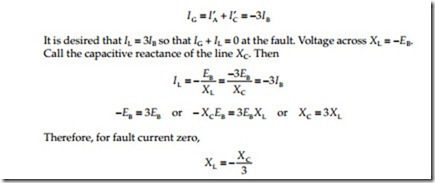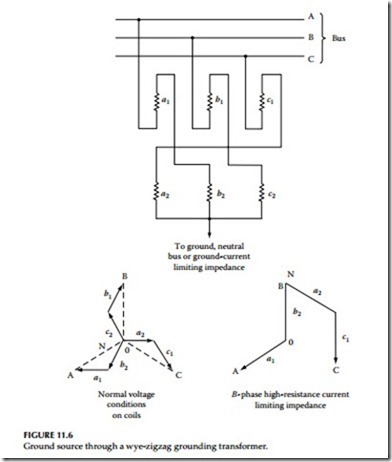Selection of Grounding Method
The selection of a method for power system grounding is very difficult because a large number of factors must be considered before a power system grounding method can be chosen. The following discussion outlines some problems with various grounding methods and explains how and why grounding systems are applied.
Ungrounded Systems
Early electrical systems were almost universally operated ungrounded. On small systems an insulation failure on one phase did not cause an outage. The failure could probably be found and repaired at a convenient time without a forced outage. This worked well as long as the systems were small. However, as systems increased in size and voltage rating, an increasing number of insulation failures produced multiple failures and major faults. At first, the reasons for these failures were not understood, and considerable work was done to find why they occurred. Figure 11.1 shows a typical ungrounded neutral system. Actually, it is a capacitive grounded neutral system, the capacitance being the conductor capacitance to ground. In normal operation, the capacitive current of all three lines is leading the respective line to neutral voltages by 90°, and the vector sum of all three currents is zero. Figure 11.2 shows what happens when the system
of Figure 11.1 is accidentally grounded. The charging current of the faulted phase goes to zero because its voltage to ground is zero. The voltages of the unfaulted phases increase to full line-to-line value with respect to ground, and their charging currents increase proportionally. In addition, because of the 30° shift of the line voltages with respect to ground, the charging currents shift accordingly, and the sum of the charging currents in the unfaulted phases is three times the normal value and appears in the ground, returning to the system through the fault. If the fault can be interrupted, it will most likely be done at a current zero. However, since the current leads by 90° in
the capacitive circuit, current zero occurs at the instant of a voltage maximum; thus, if the fault momentarily clears, a high voltage immediately appears across the fault, and restrike of the fault will probably occur.
In the momentary interval of time that the fault has been cleared the excessive voltage charge of the capacitors on the unfaulted lines has been trapped as a direct current (DC) charge. When the arc restrikes again: the capacitors are again recharged by a line-to-ground voltage added to the trapped charge. Thus, a restrike after another current zero clearing is more inevitable, adding another charge. The phenomenon thus probably becomes an oscillating and self-perpetuating buildup in voltage, which eventually will lead to an insula- tion failure on another phase and a major two-phase fault. While the first failure may have been a tree branch in the line, the second failure may occur at some other location entirely, perhaps involving expensive equipment insulation, such as a transformer. Thus, the principal advantage claimed for the ungrounded system actually caused troubles that resulted in its abandonment.
These troubles coupled with other factors led to the adoption of grounded neutral systems in some form. Some of the other factors were as follows:
Because of greater danger to personnel, code authorities frowned on ungrounded systems.
Equipment costs were generally lower for equipment rated for grounded neutral systems because of the reduction in insulation permissible; because graded insulation could be used, single-bushing, single- phase transformers could be used.
At the higher voltages being used today (69 kV and above), material savings in transformer costs can be realized by employing reduced basic insulation level (BIL). These savings are in addition to the modest savings above, and may amount to substantial savings in the cost of transformers in the various voltage classes with reduced insulation. The requirements for safely reducing insulation level demand that system neutrals be grounded. Thus, these savings are not available on the ungrounded system.
Solidly Grounded Systems
The simplest and most effective method of grounding is to solidly connect the neutrals of any wye-connected transformers or generators to ground. This method has two major advantages:
It is simple and inexpensive in that it requires no extra equipment.
It minimizes the magnitude of the overvoltage that will appear on the unfaulted phases during a ground fault, resulting in a reduction in the stress on insulation as compared with other methods.
This is the reason that solidly grounded neutrals are a necessity where reduced BIL insulation is to be used.
In spite of the advantages of the solidly grounded system, there are associated disadvantages such that other grounding methods are often used. These disadvantages all stem from the fact that a solidly grounded system produces the greatest magnitude of ground fault current when a fault to ground occurs.
It is realized that with a grounded neutral system perhaps 95% or more of all faults start as a single phase to ground fault. If the amount of ground current that flows can be controlled and the fault cleared promptly, the amount of damage at the fault will be reduced and the fault probably restricted so as not to involve more than one phase. This may result in preventing bumdowns, reduction in the cost of making repairs, and reduction in the frequency or extent of maintenance on the breakers that interrupt the fault. In the case of machines or transformers, the difference in repair cost may be that of replacing a few damaged coils as compared with completely replacing the machine or transformer, which may be necessary where oil fires and explosion follow the transformer fault, or where heavy fault currents melt down coils and burn and weld together expensive areas of laminated electrical steel in the transformer core or machine stator iron. Since the damage done is approximately proportional to I2t, it is obvious that much more can be done in the reduction of current than by reduction in time. Figure
11.3 shows the relationship of impedances controlling three- and single-phase to ground faults. Under certain conditions, single phase to ground faults can give rise to short-circuit currents 50% in excess of three-phase short-circuit current. Thus, breakers whose ratings make them entirely capable of inter- rupting three-phase faults may be in severe difficulty handling a single phase to ground fault. In view of this, the potential savings in damage and repair costs or avoiding the cost of having to install larger breakers may justify avoiding the simple and inexpensive solidly grounded system in favor of a more complex and expensive system that will provide control of the amount of fault current.
Reactance and Resistance Grounded Systems
Reactors are commonly employed as neutral impedance for ground current limitation when the amount of current reduction is small. This is because reactors of low ohmic value to handle large quantities of current can be built quite inexpensively as compared with a resistor for the same current limita- tion. Reactors to provide current limitation to values less than approximately 30%–50% of value are not practical. This is true partly because the high ohmic values necessary to provide the higher current limitation makes them more expensive than resistors, and partly because high values of reactance grounding approach the conditions of ungrounded systems and give rise to high transient voltages.
Resistors are generally used where it is desired to limit fault currents to moderate to small values. The directly connected resistor is not practical for extremes of current limitation. Reactors are used where a small reduction of current is required, because a resistor large enough to handle the large quantities of current remaining would have to have resistor grids of tremendous cross section or many parallel grid paths, and as a result would be very expensive. On the other hand, if extreme limitation of ground cur- rent by resistors is desired, the resistor again becomes excessively expen- sive. This is because there are maximum values of resistance that it is practical to build into a resistor unit before the cross-sectional area of the resistance conductor becomes so small as to make it too susceptible to mechanical failure from shock, rust, corrosion, and the like. Thus, to get very high values of resistance, the resistor must be made up by connecting a tremendous number of moderate resistance units in series and it becomes expensive and bulky.
A variation of the directly connected resistor is used, where it is desirable and practical to limit ground fault currents to extremely low values, to avoid the expense and difficulties of the very high value resistance. A distribution transformer is connected between the neutral to be grounded and ground. A resistor is then connected across the secondary of the transformer, as shown in Figure 11.4. The actual 0.25 Ω resistor in the transformer secondary is stepped up in value as it appears to the generator neutral by the square of the transformer ratio of 13,200/240 or 3024 times. Thus, the 1/4 Ω secondary resistor appears as a 756 Ω resistor in the generator neutral. This limits the ground fault current to a maximum of 11.5 A. This represents only a small percent of current on the basis of machine full-load current and of the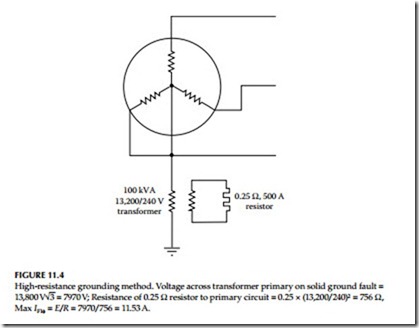
maximum three-phase fault current available. This is representative of the extreme of current limitation. It accomplishes the ultimate in the reduction of fault damage. Further reduction of fault current would be dangerous, because if it were attempted, the capacitance of the generator and step-up transformer windings and the generator lead bus duct would predominate over the higher values of resistance, and the system would approach the characteristics of the original ungrounded system of Figure 11.1 with its dangers of arcing grounds.
Resonant Grounding
One of the earliest methods of attempting to eliminate the faults of the ungrounded system and still retain the claimed advantages for it was by means of resonant grounding using the Peterson coil. This method attempted to eliminate the fault current that could cause the arcing ground condition. Figure 11.5 shows the system of Figures 11.1 and 11.2 with the Peterson coil applied. This is simply a tunable, iron-cored reactor connected between neutral and ground. It is tuned so that the current it furnishes matches the current furnished by line capacitance under fault conditions. Under normal system conditions, it does not carry current. However, upon the occurrence of a fault it contributes a reactive component of current through the fault matching the capacitive component. Since the two currents are 180° out of phase, they cancel. This leaves no current at the fault, minimizes the chance of restrike, and thus eliminates the cause of voltage buildup.
The ground-fault neutralizer is said to be effective in 70%–80% of the faults. It is not in great favor because it is not 111% effective, because of its expense, and because of the expense of the equipment necessary to protect it in the 20%–30% of the cases when it does not work. The principal cause of its failure to work is improper tuning. This might seem to be easily corrected, but when it is realized that retuning would be required upon each feeder extension or
rearrangement, for each emergency switching condition, or that even if kept properly tuned the system could be detuned by a broken conductor associated with the fault it was to clear, some of the difficulties of its application can be realized. It can work well in a three-phase radial circuit. However, it is not practical in a tie feeder or network system unless it is blocked off by delta transformers or other zero-sequence impedance isolators so that the tuned setting required can be definitely known and is not variable because of system operating conditions. To calculate the reactance value of the neutral reactor, the following equation from Figure 11.2 can be used:
Grounding Ungrounded Systems
So far the discussion of grounding has assumed a wye-connected neutral to ground. This is not always the case, and in some cases it is not a three-phase system that it is desired to be grounded. For situations of this kind a grounding transformer is used. This may be a conventional wye-delta transformer of suitable rating or a special zigzag wye unit may be used. Once the neutral is established, any of the grounding methods already discussed may be employed, provided the rating of the grounding transformer is adequate for the amount of current permitted by the grounding method used. Figure 11.6 shows the setup of a zigzag wye transformer used for the grounding.
In the selection of grounding equipment and methods, many factors must be considered. It is desirable from the reduction of fault damage, repair costs, and switching equipment maintenance to limit ground fault current as much as possible. However, the greater the limitation of current, the higher the possible transient overvoltages that will be encountered. This will determine the equipment insulation levels required and the rating of lightning arresters required to protect the equipment, and will consequently affect costs. Therefore, these factors are in conflict with the desire for maxi- mum fault limitation. Whether resistors or reactors are used will determine the degree of overvoltage expected on a given system for a given degree of current limitation and thus affects the selection of the use of resistors or reactors.
Whenever grounding of any kind is used, it is obvious that fault current will flow when a normally ungrounded conductor becomes grounded. It is necessary that relays, fuses, or other protective devices sense and operate to clear the fault. Since the degree of current limitation employed may well have a serious effect on the ability of these devices to operate as desired, it follows that the degree of current limitation that can be employed may well be deter- mined by the sensitivity of protective devices used, or, conversely, the type and sensitivity of the protective devices required may be determined by the degree of current limitation selected. However, since a multiplicity of feeders at generator voltage depends upon ground overcurrent relays for their ground fault protection, ground fault current must be kept up to a value that will give adequate relay operating torque for any and all ground faults on them, with reasonable current transformer ratios and relay current ranges.
Thus, the selection of the value to which the ground fault is to be limited becomes the problem of making a selection between minimum ground fault current to limit damage, the minimum ground fault that will give adequate protective device operation, and the maximum ground fault current that the generator windings can tolerate before there is danger of the magnetic forces forcing windings out of the generator armature slots. The extreme ground current limitation can be used only where there are no feeders at generator voltage that must have ground fault protection, and delta-wye transformers isolate the zero-sequence network for which ground fault protection at this very low current level must be provided to a very small number of equipment units. Even then, very special relaying methods must be employed.
In conclusion, several important points with respect to impedance grounding of system neutrals are so obvious that they are often overlooked.
1. Since grounding equipment is electrically active in a circuit only during a ground fault, considerable money can be saved by buying equipment rated for short time duty. Grounding equipment for a station with all underground circuits will be expected to be subjected to very infrequent faults, and since cable faults are usually permanent, repeated reclosing attempts will probably not be made. Under these circumstances a short time rating of the grounding equipment of 11 s or less may be adequate. However, grounding equipment installed in a station having all overhead circuits will be subjected to the cumulative heating effect of perhaps many closely spaced feeder faults during severe storm conditions, each circuit outage being accompanied by several unsuccessful closing attempts. Under these conditions, equipment having a rating on a 10 min or more basis may be inadequate.
2. Impedance neutral grounding equipment must always be considered hot because if a ground fault occurs in the system, it will raise the neutral to full phase to ground voltage. This not only poses a safety problem but also creates the problem of how to maintain the equipment, unless the machine, bus, or station for which the impedance furnishes the ground is shut down.
3. Where a multiplicity of grounding units is employed, care must be exercised in switching facilities for their transfer to avoid the danger that someone will get caught operating disconnects for the transfer just as a ground fault occurs. If multiple units are used, care must be exercised to assure that the protective relaying will operate and coordinate properly through the range of conditions possible with the multiple units.
4. Where impedance grounding is used, no other neutrals in the same zero-sequence system may be grounded except through the same impedance. To do so will shunt or short circuit the original impedance and raise the ground fault current above the desired design value.
